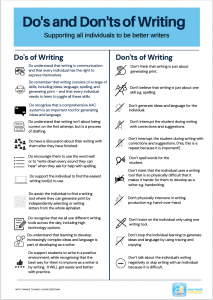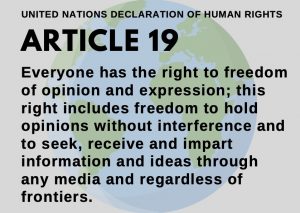Last year, I had a request to make up a Do's and Don't s of Writing poster - and I thought this was a fabulous idea! So, I am happy to present the "Do's and Don'ts of Writing: Supporting all individuals to be better writers."

And now, because it wouldn't be me without a whole lot of words to follow, I get to expand on each of these points!

Writing is how we express ourselves. For anyone with complex communication needs, it is the ultimate goal. Being able to write means that you can say anything you want.
Unfortunately, the history of special education tells us that we haven't done a great job with teaching writing. Katims (2000) referred to much of our writing instruction as "reductionist interventions" because we have frequently reduced our instruction to focus on just one of the skills of writing - which frequently has been a focus on handwriting. Writing is a very complex series of tasks and if we don't teach all of the skills involved, then students won't learn all of those skills.
And - once we have students who are developing as writers - we need to accept that writing is, indeed, about self-expression. We might not always like what students write - but we have to respect that it is their human right to express themselves.


This point once again refers back to our history of reductionist interventions. Writing consists of a complex series of skills and every individual needs to learn to do all of these skills to become an independent writer. Writing isn't about just one skill - our history in special education has proven that focusing on just one of these areas, such as spelling, doesn't lead to good outcomes. We need to ensure that every individual gets an opportunity to experience all the parts of writing to continue to develop.

Many of the students that I work with have difficulty generating ideas and language to use in writing. I believe this is because writing involves juggling so many skills - and they can struggle with all or any of them. Over years I've seen a lot of education staff deal with this difficulty by generating ideas and language for the individual - but this isn't a strategy that helps in the long term. One of my favourite things to say in a discussion of writing is "when you introduce a scaffold or support - consider whether it will be available to them in supermarket when they need to send a text message". If the scaffold or support isn't going to be available to them in a range of environments, then we either don't use it, or we have a plan to use it for the short term and remove it.
An adult generating the language and ideas for a student is never an appropriate scaffold or support. Students learn nothing when we do it for them. So we need to look at scaffolds or supports that will help them learn to do this skill. We've had great success in using comprehensive AAC systems for both students with and without complex communication needs. If a student is writing about a topic they can use the comprehensive AAC system to support their ideas and language generation. For example, if they are writing about sports day at school and can't think of ideas, they can navigate to the sports page in a comprehensive AAC system and see a range of options which they can independently choose from. This allows them to have a scaffold that doesn't push them in a specific direction as an adult partner unintentionally might. And a comprehensive AAC system can be available in the supermarket 🙂
![]()
When I worked supporting included students in mainstream settings, I frequently observed writing interactions that went like this:
- Adult: "OK - write the word safe. S......a......f......e......."
- Student writes: sav
- Adult: "No, not v. Rub that out. Now write f......"
- Student rubs the whole word out
- Adult: "OK. Start again. You're writing safe. S-a-f-e".
- Student writes: suf
- Adult: "No, not u. You need to write an a."
- etc
In each of these interactions, the adult involved had the best of intentions - but unfortunately the constant interruptions and corrections send a strong message of "can't" to the student. Additionally, studies into teaching writing show that an insistence on being correct in the first draft means that students are less likely to develop and flourish as writers - they won't take risks and they don't get enough practice to move to the next level.
So, we should never interrupt a student while they are writing. You can have a discussion with them before writing and a discussion after writing - but during writing we need to sit back and let them have a go.
As I wrote the do's and don'ts list, I wrote a bit, thought, wrote some more, removed a bit, rephrased it, and reordered it. When I'd finished, I went through it again - two or three more times. I used a spell checker to see if I had missed any errors and I asked my friend, Mary-Louise, to read it and give me feedback - but I didn't start serious editing until I'd had an opportunity to write to a point where I was ready to edit . If anyone had interrupted me with suggestions, ideas or corrections it would have just annoyed me - and many students feel the same!
![]()
OK - with this one, I pretty much repeated myself. This was deliberate though. Please, please, don't do the interrupting thing! Keep your discussions to writing conferences before the student writes (if needed) and after they have written.

Spelling supports is another area where you need to consider "will it be available in the supermarket?". If a student needs assistance in spelling words, think carefully about the strategies that you can use that will lead to long term outcomes.
Telling a student to "write down every sound you can hear" teaches them a skill that they can use anywhere - and the more they do it, the better they get at it. You also want to make sure that you do a good, solid working with words block where you teach them skills in this area.
Similarly, a student finding the word independently on a word wall and then writing it, is a routine that helps them learn sight words which leads to increased independence. It also teaches them some skills that they can use with word prediction, which is probably also available to them as they send a text in the supermarket.
However, an adult spelling words for a student doesn't teach them anything - except that we can do it and they can't. Additionally, it is a scaffold that isn't available to them at other times. So, please don't do this!!!!

As I mentioned earlier, there is a history in special education of focusing on handwriting in writing instruction. I have been working in special education for 30 years and for the whole of that time we have had alternative writing tools available that students could use instead of handwriting - however I have come across a lot of students where the team wants them to achieve a certain level of proficiency with handwriting before other writing tools are used. I agree that handwriting is a commonly used writing tool, but it isn't the only one available - and in the current time it is being used less and less.
I want you to seriously consider what a student at school in 2021 will write when they finish school. I asked a number of groups of school staff this question during 2020 and the answers were usually "text messages, emails, social media". It is extremely difficult to do any of those tasks with handwriting - so why would you focus on teaching a student to handwrite in the writing block when it is a tool they might use rarely? Keyboarding is actually the most important skill for them to learn; keyboarding will allow them to do all of those writing tasks and more.
Additionally, I want you to think about learning a new set of skills. How easy is it to learn something that is very physically difficult for you? And if your teacher could make it easier in some way, wouldn't that make it easier to learn the skills? For many students, handwriting adds to the difficulty of learning writing, where a physically easier writing tool, such as a keyboard, can make it easier and give them an opportunity to focus on some of the other skills such as language, spelling and ideas.

Independence in writing is key. A student needs to be able to generate their own ideas, use their own words, have their own attempts at spelling - AND they need to be able to use their writing tool independently. Part of our job is to find a physically easy writing tool that gives them access to the whole alphabet and that they can use independently to select letters. They can select letters by pointing, press keys or use partner assisted scanning - but whatever access method they use that independence is important.

This one is pretty self-evident! It's ok if the student uses different pencils for different tasks, just as we do through the day.

As I said earlier, a student needs to learn to independently generate ideas and language. We have used strategies to avoid this which haven't worked - and copying and tracing fall into this category. Even for a simple writing task, such as writing your name, copying and tracing don't encourage a student to think and to develop the skills they need to write independently. I write a blog post back in 2014 that explains this at length - "Balanced literacy instruction: Writing for real reasons".
The other reason that many teams focus on copying and tracing is because they believe this will help the student to get better at handwriting. Which brings us back to the discussion about a focus on handwriting above....


The best way to get better at writing is to write.
Writing in a positive environment where we value every student as a writer, and help them to move to the next stage in their writing development, is what we want to see. I work with a lot of schools every year, and at least a few times every year I go into a classroom where I am given a list of what a student can't do in writing - rather than focusing on what they can do. We need to make sure that we provide a positive environment where we believe that every student can!
Happy writing - and I hope you enjoy the challenge of supporting each and every student to be a better writer as much as I do.


Toby Scott
jane
Rosemary Crossley
jane
Andrew Stokes
jane
Elizabeth
jane